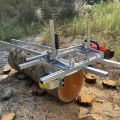Like with any new tool, there’s a sudden rush of excitement you feel the day you get your brand new chainsaw and I’m sure you can’t wait to get started. However, before you go firing that bad boy up and hacking away at everything in sight, there are a few tips you need to follow for how to use a chainsaw safely so that you do not injure yourself or others.
Neglecting to take these steps seriously could result in some injuries to yourself or others. Therefore, to make sure you know exactly what you’re doing safely and with confidence, this article will provide you with a rundown of the safe operation of a chainsaw, including the right equipment for protection, starting procedures, and cutting tips.
Table of Contents
- Appropriate Personal Protective Equipment (PPE)
- Personal Injury Preparation
- Create a Safe Environment
- How to Prepare Your Chainsaw
- How to Start the Chainsaw Safely
- How to Safely Use a Chainsaw Tips
- FAQs (Frequently Asked Questions)
Appropriate Personal Protective Equipment (PPE)
Too many people often neglect the use of correct PPE equipment. But, did you know that there are around 36,000 chainsaw accidents that require a person to visit the hospital each year? Sure, some of these accidents couldn’t have been prevented, but others certainly could have been if the person was wearing the correct personal protective gear.
I’m sure you’ve seen lumberjacks in the movies cutting down trees in a pair of jeans without a shirt on and you probably want to be that guy, but that’s not something you should ever, ever do. Safety should always be your number one priority every time you pick up and use your chainsaw. To do this, you will need to start with the correct protective clothing.
A good set of suitable PPE to own includes:
- Hard hat or chainsaw helmet
- Slip-resistant and cut-protection gloves
- Eye-protective goggles (or a helmet that includes a face protector)
- Cut-retardant or steel toe boots
- Chaps with at least five layers of cut-retardant material
It seems like overkill if you are just going to cut up a few limbs that came down in last night’s high winds, and you may hear snickers from the neighbors, but full PPE is a good habit to get into, as nonchalance can result in tragic accidents.
If you didn’t fancy buying all these pieces of equipment separately, you could find kits similar to this one readily available on Amazon:
- Chainsaw Chaps - Provides protection while working with a chain saw and other equipment. These ASTM189-14 & F3325-19 SA32851 Class B chaps are water and oil resistant. These chaps include a pocket, adjustable belt and are designed like aprons for easy on/easy off use.
Prices pulled from the Amazon Product Advertising API on:
Product prices and availability are accurate as of the date/time indicated and are subject to change. Any price and availability information displayed on [relevant Amazon Site(s), as applicable] at the time of purchase will apply to the purchase of this product.
The kit includes chainsaw pants, ear muffs, safety glasses, and a helmet! The one thing it doesn’t include however is suitable gloves like these 12-layer saw protection gloves readily available on Amazon:
- Ideal for logging, forest, metal working, hand tools, power tools and DIY works
Prices pulled from the Amazon Product Advertising API on:
Product prices and availability are accurate as of the date/time indicated and are subject to change. Any price and availability information displayed on [relevant Amazon Site(s), as applicable] at the time of purchase will apply to the purchase of this product.
Personal Injury Preparation
Let’s not act irresponsibly and presume that an injury is never going to happen, because it might, and if it does it is best to have some sort of preparation in place for when an injury occurs. Whenever you’re using a chainsaw, it’s best to have someone with you. This way, if an injury does occur you will have someone who can help.
Note: If you do have someone come with you (or there are others around), you should keep a distance of at least 2 tree lengths (150 feet) between you and the bystanders when felling a tree and at least 30 feet when removing limbs or cutting a felled tree.
However, if you have no other option than cutting alone, make sure you have a mobile phone with you that has good reception where you are. Along with this, you should set up a point of contact (emergency contact) ahead of time that you can call if something bad does occur.
The worst-case scenario is that you’re unable to drive yourself to the hospital. If this occurs, at least you have your buddy who can either take you or get you some help immediately.
Create a Safe Environment
The final tip before picking up your chainsaw is by creating a safe environment to use it in. It’s always important to take a good look around the spot you’re going to be cutting to make sure there’s nothing there that could potentially cause problems.
Before you begin cutting, you must vigorously check the environmental safety of your specific situation. Particularly with felling, look up, look down, look around. Is there an escape route for you to take when the tree falls? Is there a clear path for the tree to fall?
If it goes in an unintended direction, what would be the consequence — does something get hit like the shed or the power line? Is the tree weakened by any sorts of bugs or diseases? Is the wind blowing from the direction that you want the tree to fall?
Check for things like dangling trees, hidden electrical cables, foot obstructions, wildlife, or anything else that may cause issues while you’re cutting. Check the wood itself for any nails, screws, or other metal objects that may have been inserted without your knowing. You never want to cut through those types of things with your chainsaw.
What you should do every time before using your chainsaw, is ask yourself if you are comfortable with the sawing task at hand, and you should not be afraid to say “no.”
How to Prepare Your Chainsaw
Now that you’ve created a safe environment to use the chainsaw within, we can focus on the preparation of your chainsaw before starting it. Let’s check the:
- Chain tension
- Power source
- Bar and chain oil
Chain Tension
The first of the preparations is to check the chain tension. You must make sure the chain is not slipping off the guide bar nor is too tight. If either is the case, you should adjust the chain.
Power Source
If you’re using a 2-cycle gas-powered chainsaw, make sure it’s filled with the proper oil-to-gas ratio of mix. In most cases, it will usually be 40:1 or 50:1. per the manufacturer’s instructions. If you’re using a battery chainsaw, you must ensure the batteries are fully charged. And finally, if you’re using a corded electric chainsaw, you must ensure it’s plugged into a suitable power outlet.
Bar and Chain Oil
Finally, you need to make sure that the bar and chain oil reservoir is filled appropriately. If you have a manual oiler, you should give it a few pumps to lubricate the chain. If you have an automatic oiler, you don’t have to do anything!
If you’re interested in bar and chain oil substitutes, visit our guide!
How to Start the Chainsaw Safely
The starting process varies from the different types of chainsaw. Here are tips on how to safely start a chainsaw for each type:
- Gas-powered
- Battery-powered and corded
Gas-Powered Chainsaws
To safely start your gas-powered chainsaw, follow these 8 simple steps:
- Place the chainsaw on level ground and put your right foot through the rear handle, stepping down on it to keep the chainsaw steady.
- Place your left hand on the top handlebar and grip it tightly while using your right hand to engage the chain brake so the chain doesn’t spin.
- Turn the on/off switch to the “on” position before opening the choke.
- If your chainsaw has a fuel primer, you should press it several times until fuel can be seen within the bulb.
- Pull up fast on the starter cord using your right hand.
- When the engine begins to turn over, push the choke back in half before pulling up on the starter cord again.
- Squeeze the throttle a few times quickly to rev up the engine’s idle as soon as the engine starts before adjusting the choke to the run position.
- Once you’re ready to start cutting, release the chain brake.
Battery Powered and Corded Chainsaws
To safely start your battery-powered or corded chainsaw, follow these 2 simple steps:
- Press and hold the safety lock button to make the switch trigger operational.
- Then press and hold the trigger switch to start the chainsaw and keep the trigger pressed for continued operation.
How to Safely Use a Chainsaw Tips
When using a chainsaw, you always want to stand to the left side of the powerhead no matter if you’re carrying out limbing, bucking, or felling tasks.
You should never take your eyes off of the chain when you’re cutting and never cut with the tip of the chainsaw. The latter may cause a kickback of the blade and may strike your face or body. You should always cut branches as close to the base of the blade as possible and always use two hands to hold the chainsaw. You should never cut one-handed.
Always watch the wood as you’re cutting. If you see the cut in the wood start to pinch the chain, you should immediately stop cutting and rotate around the wood or rotate the wood itself. A pinched chain can cause kickback.
Never let the chainsaw chain touch the ground or hit dirt while you’re sawing because if you do, it will dull the chain and then it won’t cut very well.
If you’re bucking a tree and your chainsaw has bucking spikes, you should use them. Bucking Spikes are metal teeth at the base of the guide bar that let you dig into the wood. This gives you a solid pivot point so you can get a cleaner cut.
Always cut below waist level. You may be tempted to hack away at tree branches that are above your head but, you should never when operating a chainsaw because the risk of injury is not worth it. The safest way to use a chainsaw is at waist level or below as this will give you the best control over the tool.
Finally, never climb a tree with a chainsaw or cut from a ladder. You should buy a pole saw if you need to cut branches that require you to climb.
FAQs (Frequently Asked Questions)
How do you use a chainsaw for beginners?
First, make sure you have the correct PPE before doing anything. This includes steel toe cap boots, gloves, hardhat, glasses, etc. Next, you should create a safe environment to work in by checking for any potential hazards. You will then need to prepare the chain saw (chain tension, bar, and chain oil) before starting your chainsaw as per the user instructions manual.
What should you not do with a chainsaw?
You must never take your eyes off of the chainsaw chain when you’re cutting and as well never cut with the tip of the chainsaw. The latter is likely to cause a kickback of the blade which may lead to it striking your face or body. You should always cut branches as close to the base of the blade as possible and always use two hands to hold the chainsaw at all times. Never cut one-handed.
What safety precautions are needed when using a chainsaw?
Correct personal protective equipment (PPE) must be worn when operating the chainsaw, which includes hand, foot, leg, eye, face, hearing, and head protection. You should not wear loose-fitting clothing. Next, it’s always important to take a good look around the spot you’re going to be cutting to make sure there’s nothing there that could potentially jeopardize safety. Finally, learning how to safely use the chainsaw and abiding by these rules is imperative.
How do you stop a chainsaw kickback?
One way to avoid chainsaw kickback is by paying attention to and ensuring you never cut with the nose/tip of your chainsaw. You could install a safety tip that covers the nose of the guide bar on the saw to prevent contact with the kickback zone on the nose. Otherwise, while cutting you should stand to the side of the cutting path of the chain saw. Position yourself so that you are not close to the cutting attachment when the chain saw is running.







